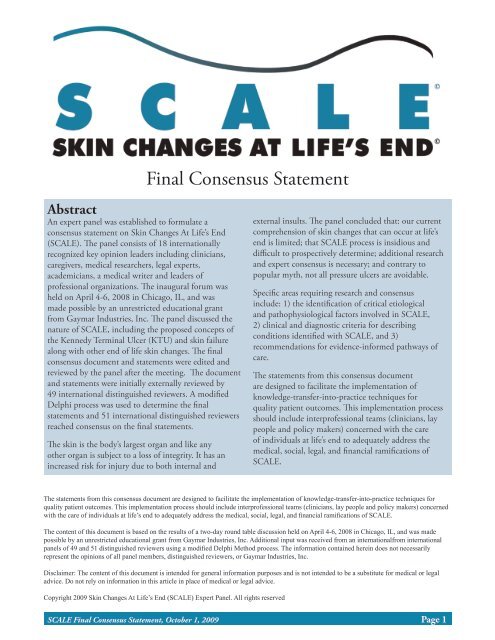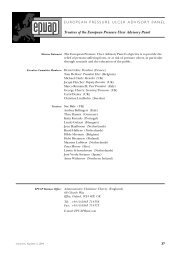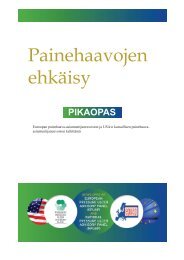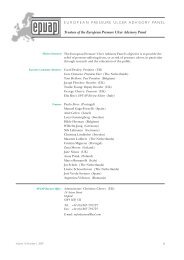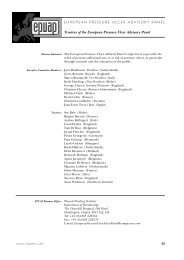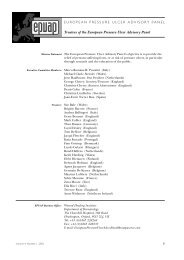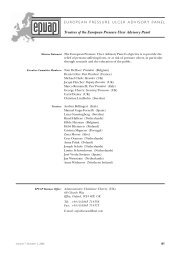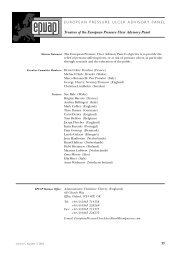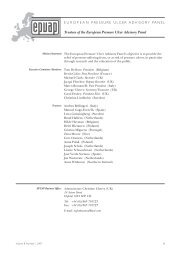SCALE Final Consensus Statement - European Pressure Ulcer ...
SCALE Final Consensus Statement - European Pressure Ulcer ...
SCALE Final Consensus Statement - European Pressure Ulcer ...
Create successful ePaper yourself
Turn your PDF publications into a flip-book with our unique Google optimized e-Paper software.
<strong>Final</strong> <strong>Consensus</strong> <strong>Statement</strong><br />
Abstract<br />
An expert panel was established to formulate a<br />
consensus statement on Skin Changes At Life’s End<br />
(<strong>SCALE</strong>). The panel consists of 18 internationally<br />
recognized key opinion leaders including clinicians,<br />
caregivers, medical researchers, legal experts,<br />
academicians, a medical writer and leaders of<br />
professional organizations. The inaugural forum was<br />
held on April 4-6, 2008 in Chicago, IL, and was<br />
made possible by an unrestricted educational grant<br />
from Gaymar Industries, Inc. The panel discussed the<br />
nature of <strong>SCALE</strong>, including the proposed concepts of<br />
the Kennedy Terminal <strong>Ulcer</strong> (KTU) and skin failure<br />
along with other end of life skin changes. The final<br />
consensus document and statements were edited and<br />
reviewed by the panel after the meeting. The document<br />
and statements were initially externally reviewed by<br />
49 international distinguished reviewers. A modified<br />
Delphi process was used to determine the final<br />
statements and 51 international distinguished reviewers<br />
reached consensus on the final statements.<br />
The skin is the body’s largest organ and like any<br />
other organ is subject to a loss of integrity. It has an<br />
increased risk for injury due to both internal and<br />
external insults. The panel concluded that: our current<br />
comprehension of skin changes that can occur at life’s<br />
end is limited; that <strong>SCALE</strong> process is insidious and<br />
difficult to prospectively determine; additional research<br />
and expert consensus is necessary; and contrary to<br />
popular myth, not all pressure ulcers are avoidable.<br />
Specific areas requiring research and consensus<br />
include: 1) the identification of critical etiological<br />
and pathophysiological factors involved in <strong>SCALE</strong>,<br />
2) clinical and diagnostic criteria for describing<br />
conditions identified with <strong>SCALE</strong>, and 3)<br />
recommendations for evidence-informed pathways of<br />
care.<br />
The statements from this consensus document<br />
are designed to facilitate the implementation of<br />
knowledge-transfer-into-practice techniques for<br />
quality patient outcomes. This implementation process<br />
should include interprofessional teams (clinicians, lay<br />
people and policy makers) concerned with the care<br />
of individuals at life’s end to adequately address the<br />
medical, social, legal, and financial ramifications of<br />
<strong>SCALE</strong>.<br />
The statements from this consensus document are designed to facilitate the implementation of knowledge-transfer-into-practice techniques for<br />
quality patient outcomes. This implementation process should include interprofessional teams (clinicians, lay people and policy makers) concerned<br />
with the care of individuals at life’s end to adequately address the medical, social, legal, and financial ramifications of <strong>SCALE</strong>.<br />
The content of this document is based on the results of a two-day round table discussion held on April 4-6, 2008 in Chicago, IL, and was made<br />
possible by an unrestricted educational grant from Gaymar Industries, Inc. Additional input was received from an internationalfrom international<br />
panels of 49 and 51 distinguished reviewers using a modified Delphi Method process. The information contained herein does not necessarily<br />
represent the opinions of all panel members, distinguished reviewers, or Gaymar Industries, Inc.<br />
Disclaimer: The content of this document is intended for general information purposes and is not intended to be a substitute for medical or legal<br />
advice. Do not rely on information in this article in place of medical or legal advice.<br />
Copyright 2009 Skin Changes At Life’s End (<strong>SCALE</strong>) Expert Panel. All rights reserved<br />
<strong>SCALE</strong> <strong>Final</strong> <strong>Consensus</strong> <strong>Statement</strong>, October 1, 2009 Page 1
<strong>SCALE</strong> Expert Panel Members<br />
Co-Chairpersons<br />
R. Gary Sibbald, BSc, MD, FRCPC (Med, Derm),MACP, FAAD, MEd, FAPWCA University of Toronto,<br />
Toronto, Canada, gary.sibbald@utoronto.ca<br />
Diane L. Krasner, PhD, RN, CWCN, CWS, BCLNC, FAAN, Wound & Skin Care Consultant, York, PA,<br />
USA, dlkrasner@aol.com Corresponding Author: 212 East Market Street, York, PA 17403 USA<br />
Medical Writer<br />
James Lutz, MS, CCRA, Lutz Consulting, LLC, Medical Writing Services, Buellton, CA, USA, jlutzmail@<br />
aol.com<br />
Panel Facilitator<br />
Cynthia Sylvia, MSc, MA, RN, CWOCN, Gaymar Industries, Inc., Orchard Park, NY, USA, csylvia@<br />
gaymar.com<br />
Additional Panel Members<br />
Oscar Alvarez, PhD, CCT, FAPWCA, Center for Curative and Palliative Wound Care, Calvary Hospital,<br />
Bronx, NY, USA, oalvarez@calvaryhospital.org<br />
Elizabeth A. Ayello, PhD, RN, ACNS-BC, ETN, FAPWCA, FAAN, Excelsior College School of Nursing,<br />
USA, elizabeth @ayello.com<br />
Sharon Baranoski, MSN, RN, CWOCN, APN, DAPWCA, FAAN, Wound Care Dynamics, Inc.,<br />
Shorewood, IL, USA, nrsebear@aol.com<br />
William J. Ennis, DO, MBA, FACOS, University of Illinois, Palos Heights, IL, USA, w.ennis@comcast.net<br />
Nancy Ann Faller, RN, MSN, PhD, ETN, CS, Carlisle, PA, USA, nafaller@aol.com<br />
Jane Hall, Medical Malpractice Defense Attorney, Huie, Fernambucq & Stewart, LLP, Birmingham, AL,<br />
USA, jgh@hfsllp.com<br />
Rick E. Hall, BA, RN, CWCN, Helping Hands Wound Care, Wichita, KS, USA, mnurse66@yahoo.com<br />
Karen Lou Kennedy-Evans, RN, CS, FNP, KL Kennedy, LLC, Tucson, AZ, USA, ktulcer@aol.com<br />
Diane Langemo, PhD, RN, FAAN, Langemo & Assoc, Grand Forks, ND, USA, dianelangemo@aol.com<br />
Joy Schank, RN, MSN, ANP, CWOCN, Schank Companies, Himrod, NY, USA, joyschank@yahoo.com<br />
Thomas P. Stewart, PhD, Gaymar Industries, Inc., Orchard Park, NY & S.U.N.Y. at Buffalo, USA,<br />
tstewart@gaymar.com<br />
Nancy A. Stotts, RN, CNS, EdD, FAAN, University of California, San Francisco, San Francisco, CA, USA,<br />
nancy.stotts@nursing.ucsf.edu<br />
David R. Thomas, MD, FACP, AGSF, GSAF, CMD, St. Louis University, St. Louis, MO, USA, thomasdr@<br />
slu.edu<br />
Dot Weir, RN, CWON, CWS, Osceola Regional Medical Center, Kissimmee, FL, USA, dorothy.weir@<br />
hcahealthcare.com<br />
<strong>SCALE</strong> <strong>Final</strong> <strong>Consensus</strong> <strong>Statement</strong>, October 1, 2009 Page 2
Table of Contents<br />
Abstract 1<br />
<strong>SCALE</strong> Expert Panel Members 2<br />
Background for Skin Changes At Life’s End (<strong>SCALE</strong>) 4<br />
Goals and Objectives of the <strong>SCALE</strong> Panel 5<br />
Methodology 5<br />
Panel <strong>Statement</strong>s<br />
<strong>Statement</strong> 1 6<br />
<strong>Statement</strong> 2 6<br />
<strong>Statement</strong> 3 7<br />
<strong>Statement</strong> 4 7<br />
<strong>Statement</strong> 5 8<br />
<strong>Statement</strong> 6 8<br />
<strong>Statement</strong> 7 9<br />
<strong>Statement</strong> 8 9<br />
<strong>Statement</strong> 9 10<br />
<strong>Statement</strong> 10 12<br />
Recommendations for Future Research 13<br />
Conclusions 13<br />
Glossary of Terms 14<br />
References 16<br />
List of Distinguished Reviewers 18<br />
<strong>SCALE</strong> <strong>Final</strong> <strong>Consensus</strong> <strong>Statement</strong>, October 1, 2009 Page 3
Background for Skin Changes At<br />
Life’s End (<strong>SCALE</strong>)<br />
Organ dysfunction is a familiar concept in the health<br />
sciences, and can occur at any time but most often<br />
occurs at life’s end, during an acute critical illness<br />
or with severe trauma. Body organs particularly the<br />
heart and kidneys undergo progressive limitation of<br />
function as a normal process related to aging and the<br />
end of life. End of life is defined as a phase of life<br />
when a person is living with an illness that will often<br />
worsen and eventually cause death. This time period<br />
is not limited to the short period of time when the<br />
person is moribund. 1 It is well accepted that during<br />
the end stages of life, any of a number of vital body<br />
systems (e.g. the renal, hepatic, cardiac, pulmonary,<br />
or nervous systems) can be compromised to varying<br />
degrees and will eventually totally cease functioning.<br />
The process of organ compromise can have<br />
devastating effects, resulting in injury or interference<br />
with functioning of other organ systems that may<br />
contribute to further deterioration and eventual<br />
death.<br />
We propose that the skin, the largest organ of<br />
the body, is no different, and also can become<br />
dysfunctional with varying degrees of resultant<br />
compromise. The skin is essentially a window<br />
into the health of the body, and if read correctly,<br />
can provide a great deal of insight into what is<br />
happening inside the body. Skin compromise,<br />
including changes related to decreased cutaneous<br />
perfusion and localized hypoxia (blood supply and<br />
local tissue factors) can occur at the tissue, cellular,<br />
or molecular level. The end result is a reduced<br />
availability of oxygen and the body’s ability to utilize<br />
vital nutrients and other factors required to sustain<br />
normal skin function. When this compromised state<br />
occurs, the manifestations are termed, Skin Changes<br />
At Life’s End (<strong>SCALE</strong>). It should be noted that the<br />
acronym <strong>SCALE</strong> is a mnemonic used to describe<br />
a group of clinical phenomena, and should not<br />
be confused with a risk assessment tool. The term<br />
applies to all individuals across the continuum of<br />
care settings.<br />
Skin organ compromise at life’s end is not a new<br />
concept in the literature. The first clinical description<br />
in modern medical literature appeared in 1989 with<br />
the Kennedy Terminal <strong>Ulcer</strong> (KTU). 2 Kennedy<br />
The skin is essentially a window into the<br />
health of the body, and if read correctly,<br />
can provide a great deal of insight into<br />
what is happening inside the body.<br />
described the KTU as a specific subgroup of pressure<br />
ulcers that some individuals develop as they are<br />
dying. They are usually shaped like a pear, butterfly,<br />
or horseshoe, and are located predominantly on the<br />
coccyx or sacrum (but have been reported in other<br />
anatomical areas). The ulcers are a variety of colors<br />
including red, yellow or black, are sudden in onset,<br />
typically deteriorate rapidly, and usually indicate<br />
that death is imminent. 2 This initial report was based<br />
on retrospective chart reviews of individuals with<br />
pressure ulcers. It sparked further inquiry into how<br />
long these individuals within the facility lived after<br />
occurrence of a pressure ulcer. Just over half (55.7%)<br />
died within six weeks of discovery of their pressure<br />
ulcer(s). The observations were further supported by<br />
Hanson and colleagues (1991), who reported that<br />
62.5% of pressure ulcers in hospice patients occurred<br />
in the 2 weeks prior to death. 3 Further evidence for<br />
the existence of the KTU is mostly observational in<br />
nature, but is consistent with the premise that skin<br />
function can become compromised at life’s end.<br />
It is noteworthy that while Kennedy independently<br />
described the KTU in 1989, a similar condition<br />
was actually first described much earlier in the<br />
French medical literature by Jean-Martin Charcot<br />
(1825-1893). 4, 5 In a medical textbook written in<br />
1877, Charcot described a specific type of ulcer<br />
that is butterfly in shape and occurring over the<br />
sacrum. Patients that developed these ulcers usually<br />
died shortly thereafter, hence he termed the ulcer<br />
Decubitus Ominosus. However, Charcot attributed<br />
the ulcers to being neuropathic rather than pressure<br />
in origin. Charcot’s writings of Decubitus Ominosus<br />
<strong>SCALE</strong> <strong>Final</strong> <strong>Consensus</strong> <strong>Statement</strong>, October 1, 2009 Page 4
were all but forgotten in the medical literature<br />
until recently with renewed interest in skin organ<br />
compromise. 4 The fact that two experts in the field<br />
of chronic wounds independently reported the same<br />
clinical phenomenon, with very similar descriptions,<br />
112 years apart, lends credence to the possible<br />
existence of terminal pressure ulcers as a result of<br />
end-of-life skin organ compromise.<br />
Also of historical interest is the original work of<br />
Dr. Alois Alzheimer in Germany. He was on call<br />
in 1901 when a 51 year old woman, Frau August<br />
D, was admitted to his asylum for the insane in<br />
Frankfort. Dr. Alzheimer followed this patient,<br />
studied her symptoms and presented her case to his<br />
colleagues as what came to be known as Alzheimer’s<br />
Disease. When Frau Auguste D. died on April 8,<br />
1906, her medical record listed the cause of death as<br />
“septicemia due to decubitus.” 6 Alzheimer noted, “at<br />
the end, she was confined to bed in a fetal position,<br />
was incontinent and in spite of all the care and<br />
attention given to her, she suffered from decubitus.”<br />
So, here we have the first identified patient with<br />
Alzheimer’s Disease having developed immobility<br />
and two pressure ulcers with end stage Alzheimer’s.<br />
In our modern times, end stage Alzheimer’s Disease<br />
has become an all-too-frequent scenario with<br />
multiple complications including <strong>SCALE</strong>.<br />
In 2003, Langemo proposed a working definition<br />
of skin failure; that it is a result of hypoperfusion,<br />
creating an extreme inflammatory reaction<br />
concomitant with severe dysfunction or failure of<br />
multiple organ systems. 7 Three years later, Langemo<br />
and Brown (2006) conducted a comprehensive<br />
review of the literature on the concept of skin failure<br />
that focused largely on pressure ulcer development. 8<br />
They presented a discussion of changes in the skin<br />
that can occur with aging, the development of<br />
pressure ulcers, multiorgan failure, and “skin failure”<br />
(both acute and chronic as well as end of life). 9-15<br />
In the early 1990’s two publications by Parish &<br />
Witkowski had presented logical arguments about<br />
the mechanism of pressure ulcer occurrence at<br />
the end of life, suggesting that they may not be<br />
preventable in those individuals with multiple organ<br />
failure. 11, 16 Although the term skin failure has been<br />
introduced, it is not currently a widely accepted<br />
term in the dermatological or the wound literature.<br />
Despite the limited scientific literature, there is<br />
consensus from the narrative literature that some<br />
pressure ulcers may be unavoidable including those<br />
that are manifestations of <strong>SCALE</strong>. We propose<br />
that at the end of life, failure of the homeostatic<br />
mechanisms that support the skin can occur,<br />
resulting in a diminished reserve to handle insults<br />
such as minimal pressure. Therefore, contrary to<br />
popular myth, not all pressure ulcers are avoidable. 17,<br />
18<br />
Many members of the <strong>SCALE</strong> Panel acknowledge<br />
the need for systematic study of the phenomenon.<br />
Goals and Objectives of the <strong>SCALE</strong><br />
Panel<br />
The overall goal of the <strong>SCALE</strong> Expert Panel was to<br />
initiate stakeholder discussion of skin changes at<br />
the end of life, a phenomenon that we have termed<br />
<strong>SCALE</strong>. An objective was to examine the concept of<br />
unavoidable pressure ulcers that can occur as a result<br />
of <strong>SCALE</strong>. While reaching consensus on the various<br />
aspects of this topic is an important outcome, this<br />
endeavor will require a more rigorous scientific<br />
investigative approach that was beyond the scope of<br />
this ground breaking meeting. The purpose of this<br />
initial meeting was to generate a series of statements<br />
that will serve as a platform for future consensus<br />
discussions. The objective of this document is to<br />
present these panel statements, disseminate them for<br />
public discussion, and to further the development of<br />
the body of scientific knowledge on this important<br />
topic.<br />
Methodology<br />
A modified three phase Delphi Method approach<br />
was used to reach consensus on the 10 statements<br />
reported in this document. The Delphi Method<br />
relies on expert panel input to reach consensus on a<br />
topic of interest. 19 Our approach consisted of three<br />
separate phases of consensus building involving an<br />
international group of 69 noted experts in the field<br />
<strong>SCALE</strong> <strong>Final</strong> <strong>Consensus</strong> <strong>Statement</strong>, October 1, 2009 Page 5
of wound care.<br />
Phase 1: A panel of 18 experts in the field of wound<br />
care with expertise in wound and skin care convened<br />
in a round table format on April 4-6, 2008 in<br />
Chicago, IL, USA. Audio proceedings and written<br />
notes from this round table discussion were used<br />
to generate a Preliminary <strong>Consensus</strong> Document<br />
(PCD). This PCD was returned to the original panel<br />
for review and was modified as necessary to reach<br />
panel consensus.<br />
Phase 2: The PCD was presented and distributed at<br />
numerous international conferences seeking public<br />
comment from September 2008 through June 2009.<br />
The document was published, 20 and also available<br />
for public download from the web site of the panel<br />
sponsor (Gaymar Industries, Inc.). 21 The PCD was<br />
further reviewed by a selected international panel of<br />
49 Distinguished Reviewers with noted expertise in<br />
wound care and palliative medicine.<br />
Phase 3: Written input received from the panel<br />
of Distinguished Reviewers and from the various<br />
public presentations was used to generate A <strong>Final</strong><br />
<strong>Consensus</strong> Document (FCD). This FCD was then<br />
returned to the original 18-member Expert Panel<br />
and a 52-member Distinguished Reviewer Panel for<br />
voting on each of the 10 statements for consensus. A<br />
quorum of 80% that strongly agree or somewhat agree<br />
with each statement was used as a pre-determined<br />
threshold for having achieved consensus on each of<br />
the statements. Fifty two individuals voted on the<br />
final consensus process.<br />
In addition to the PCD and FCD documents, an<br />
annotated bibliography of literature pertinent to<br />
<strong>SCALE</strong> was generated and is available for download<br />
from the web site of the panel sponsor (Gaymar<br />
Industries, Inc.). 21<br />
Panel <strong>Statement</strong>s<br />
As a result of the two-day panel discussion and<br />
subsequent panel revisions, and with input from<br />
69 noted wound care experts in a modified Delphi<br />
Method approach, the following 10 statements are<br />
proposed by the <strong>SCALE</strong> Expert Panel:<br />
<strong>Statement</strong> 1<br />
Physiologic changes that occur as a result of the<br />
dying process (days to weeks) may affect the skin<br />
and soft tissues and may manifest as observable<br />
(objective) changes in skin color, turgor, or<br />
integrity, or as subjective symptoms such as<br />
localized pain. These changes can be unavoidable<br />
and may occur with the application of appropriate<br />
interventions that meet or exceed the standard of<br />
care.<br />
When the dying process compromises the<br />
homeostatic mechanisms of the body, a number<br />
of vital organs may become compromised. The<br />
body may react by shunting blood away from the<br />
skin to these vital organs, resulting in decreased<br />
skin and soft tissue perfusion and a reduction of<br />
the normal cutaneous metabolic processes. Minor<br />
insults can lead to major complications such as skin<br />
hemorrhage, gangrene, infection, skin tears and<br />
pressure ulcers that may be markers of <strong>SCALE</strong>. See<br />
<strong>Statement</strong> 6 for further discussion.<br />
<strong>Statement</strong> 2<br />
The plan of care and patient response should be<br />
clearly documented and reflected in the entire<br />
medical record. Charting by exception is an<br />
appropriate method of documentation.<br />
The record should document the patient’s clinical<br />
condition including co-morbidities, pressure<br />
ulcer risk factors, significant changes, and clinical<br />
interventions that are consistent with the patient’s<br />
wishes and recognized guidelines for care. 22 Facility<br />
policies and guidelines for record keeping should be<br />
followed and facilities should update these policies<br />
and guidelines as appropriate. The impact of the<br />
interventions should be assessed and revised as<br />
appropriate. This documentation may take many<br />
forms. Specific approaches to documentation of care<br />
should be consistent with professional, legal, and<br />
regulatory guidelines, and may involve narrative<br />
documentation, the use of flow sheets, or other<br />
documentation systems/tools.<br />
<strong>SCALE</strong> <strong>Final</strong> <strong>Consensus</strong> <strong>Statement</strong>, October 1, 2009 Page 6
If a patient is to be treated as palliative, it should be<br />
stated in the medical record, ideally with a reference<br />
to a family/caregiver meeting, and that consensus<br />
was reached. If specific palliative scales such as the<br />
Palliative Performance Scale, 23 or other palliative<br />
tools were utilized, 24 they should be included in<br />
the medical record. Palliative care must be patientcentered,<br />
with skin and wound care being only a<br />
part of the total plan of care.<br />
It is not reasonable to expect that the medical<br />
record will be an all-inclusive account of the<br />
individual’s care. Charting by exception is an<br />
appropriate method of documentation. This form<br />
of documentation should allow the recording<br />
of unusual findings and pertinent patient risk<br />
factors. Some methods of clinical documentation<br />
are antiquated in light of today’s complexity of<br />
patient care and rapidly changing interprofessional<br />
healthcare environment; many current<br />
documentation systems need to be revised and<br />
streamlined.<br />
<strong>Statement</strong> 3<br />
Patient centered concerns should be addressed<br />
including pain and activities of daily living.<br />
A comprehensive, individualized plan of care should<br />
not only address the patient’s skin changes and comorbidities,<br />
but any patient concerns that impact<br />
quality of life including psychological and emotional<br />
issues. Research suggests that for wound patients,<br />
health-related quality of life is especially impacted<br />
by pain, change in body image, odors and mobility<br />
issues. It is not uncommon for these factors to<br />
have an effect on aspects of daily living, nutrition,<br />
mobility, psychological factors, sleep patterns and<br />
socialization. 25, 26 Addressing these patient-centered<br />
concerns optimizes activities of daily living and<br />
enhance a patient’s dignity.<br />
A comprehensive, individualized<br />
plan of care should not only address<br />
the patient’s skin changes and comorbidities,<br />
but any patient concerns<br />
that impact quality of life including<br />
psychological and emotional issues.<br />
<strong>Statement</strong> 4<br />
Skin changes at life’s end are a reflection of<br />
compromised skin (reduced soft tissue perfusion,<br />
decreased tolerance to external insults, and<br />
impaired removal of metabolic wastes).<br />
When a patient experiences <strong>SCALE</strong>, tolerance<br />
to external insults (such as pressure) decreases<br />
to such an extent that it may become clinically<br />
and logistically impossible to prevent skin<br />
breakdown and the possible invasion of the skin<br />
by microorganisms. Compromised immune<br />
response may also play an important role,<br />
especially with advanced cancer patients and with<br />
the administration of corticosteroids and other<br />
immunosuppressant agents.<br />
Skin changes may develop at life’s end despite<br />
optimal care, as it may be impossible to protect the<br />
skin from environmental insults in its compromised<br />
state. These changes are often related to other<br />
cofactors including aging, co-existing diseases and<br />
drug adverse events. <strong>SCALE</strong>, by definition occurs at<br />
life’s end, but skin compromise may not be limited<br />
to end of life situations; it may also occur with acute<br />
or chronic illnesses, and in the context of multiple<br />
organ failure that is not limited to the end of life. 8,<br />
27<br />
However, these situations are beyond the scope of<br />
this panel’s goals and objectives.<br />
<strong>SCALE</strong> <strong>Final</strong> <strong>Consensus</strong> <strong>Statement</strong>, October 1, 2009 Page 7
<strong>Statement</strong> 5<br />
Expectations around the patient’s end of life goals<br />
and concerns should be communicated among<br />
the members of the interprofessional team and<br />
the patient’s circle of care. The discussion should<br />
include the potential for <strong>SCALE</strong> including other<br />
skin changes, skin breakdown and pressure ulcers.<br />
It is important that the provider(s) communicate<br />
and document goals of care, interventions, and<br />
outcomes related to specific interventions (See<br />
<strong>Statement</strong> 2). The patient’s circle of care includes<br />
the members of the patient unit including family,<br />
significant others, caregivers, and other healthcare<br />
professionals that may be external to the current<br />
interprofessional team. Communication with the<br />
interprofessional team and the patient’s circle of care<br />
should be documented. The education plan should<br />
include realistic expectations surrounding end of<br />
life issues with input from the patient if possible.<br />
Communication of what to expect during end of life<br />
is important and this should include changes in skin<br />
integrity.<br />
Being mindful of local protected health information<br />
disclosure regulations (e.g. USA: HIPAA, 1996), 28<br />
the patient’s circle of care needs to be aware that<br />
an individual at the end of life may develop skin<br />
breakdown, even when care is appropriate. They<br />
need to understand that skin function may be<br />
compromised to a point where there is diminished<br />
reserve to tolerate even minimal pressure or external<br />
insult. Educating the patient’s circle of care up front<br />
may help reduce the chances of shock and emotional<br />
reactions if end of life skin conditions occur.<br />
This education includes information that as<br />
one nears end of life, mobility decreases. The<br />
individual frequently has a “position of comfort”<br />
that the patient may choose to maintain, resulting<br />
in a greater potential for skin breakdown. Some<br />
patients elect to continue to lie on the pressure<br />
ulcer, stating it is the most comfortable position for<br />
them. Respecting the coherent patient’s wishes is<br />
important.<br />
With the recognition that these skin conditions are<br />
sometimes a normal part of the dying process, there<br />
is less potential for assigning blame, and a greater<br />
understanding that skin organ compromise may be<br />
an unavoidable part of the dying process.<br />
The patient’s circle of care includes the<br />
members of the patient unit including<br />
family, significant others, caregivers,<br />
and other healthcare professionals<br />
that may be external to the current<br />
interprofessional team.<br />
Discussions regarding specific trade-offs in skin care<br />
should be documented in the medical record. For<br />
example, patients may develop pressure ulcers when<br />
they cannot be (or do not want to be) turned due<br />
to pain or the existence of other medical conditions.<br />
<strong>Pressure</strong> ulcers may also occur in states of critical<br />
hypoperfusion due to underlying physical factors<br />
such as severe anemia, hypoxia, hypotension,<br />
peripheral arterial disease, or severe malnutrition.<br />
Care decisions must be made with the total goals<br />
of the patient in mind, and may be dependent on<br />
the setting of care, trajectory of the illness, and<br />
priorities for the patient and family. Comfort may<br />
be the overriding and acceptable goal, even though<br />
it may be in conflict with best skin care practice.<br />
In summary, the patient and family should have a<br />
greater understanding that skin organ compromise<br />
may be an unavoidable part of the dying process.<br />
<strong>Statement</strong> 6<br />
Risk factors symptoms and signs associated with<br />
<strong>SCALE</strong> have not been fully elucidated, but may<br />
include:<br />
• Weakness and progressive limitation of<br />
mobility.<br />
• Suboptimal nutrition including loss of appetite,<br />
weight loss, cachexia and wasting, low serum<br />
albumin/pre-albumin, and low hemoglobin as<br />
well as dehydration.<br />
<strong>SCALE</strong> <strong>Final</strong> <strong>Consensus</strong> <strong>Statement</strong>, October 1, 2009 Page 8
• Diminished tissue perfusion, impaired skin<br />
oxygenation, decreased local skin temperature,<br />
mottled discoloration, and skin necrosis.<br />
• Loss of skin integrity from any of a number<br />
of factors including equipment or devices,<br />
incontinence, chemical irritants, chronic<br />
exposure to body fluids, skin tears, pressure,<br />
shear, friction, and infections.<br />
• Impaired immune function.<br />
Diminished tissue perfusion is the most significant<br />
risk factors for <strong>SCALE</strong> and generally occurs in areas<br />
of the body with end arteries, such as the fingers,<br />
toes, ears, and nose. These areas may exhibit early<br />
signs of vascular compromise and ultimate collapse,<br />
such as dusky erythema, mottled discoloration, local<br />
cooling, and eventually infarcts and gangrene.<br />
As the body faces a critical illness or disease state, a<br />
normal protective function may be to shunt a larger<br />
percentage of cardiac output from the skin to more<br />
vital internal organs, thus averting immediate death.<br />
Chronic shunting of blood to the vital organs may<br />
also occur as a result of limited fluid intake over a<br />
long period of time. Most of the skin has collateral<br />
vascular supply but distal locations such as the<br />
fingers, toes, ears and nose have a single vascular<br />
route and are more susceptible to a critical decrease<br />
in tissue oxygenation due to vasoconstriction.<br />
Furthermore, the ability to tolerate pressure is<br />
limited in poorly perfused body areas.<br />
Additional literature reviews and clinical research<br />
are needed to more thoroughly comprehend and<br />
document all of the potential risk factors associated<br />
with <strong>SCALE</strong> and their clinical manifestations.<br />
For pressure ulcers, it is important<br />
to determine if the ulcer may be (i)<br />
healable within an individual’s life<br />
expectancy, (ii) maintained, or (iii)<br />
non-healable or palliative.<br />
<strong>Statement</strong> 7<br />
A total skin assessment should be performed<br />
regularly and document all areas of concern<br />
consistent with the wishes and condition of the<br />
patient. Pay special attention to bony prominences<br />
and skin areas with underlying cartilage. Areas of<br />
special concern include the sacrum, coccyx, ischial<br />
tuberosities, trochanters, scapulae, occiput, heels,<br />
digits, nose and ears. Describe the skin or wound<br />
abnormality exactly as assessed.<br />
It is important to assess the whole body because<br />
there may be signs that relate to skin compromise.<br />
Table 1 provides a limited list of dermatologic terms<br />
that may be useful when describing areas of concern.<br />
Table 2 provides descriptive terms for lesions based<br />
on characteristics and size.<br />
<strong>Statement</strong> 8<br />
Consultation with a qualified health care<br />
professional is recommended for any skin changes<br />
associated with increased pain, signs of infection,<br />
skin breakdown (when the goal may be healing),<br />
and whenever the patient’s circle of care expresses<br />
a significant concern.<br />
There are very definite descriptive terms for skin<br />
changes that can be used to facilitate communication<br />
between health care professionals (see <strong>Statement</strong><br />
7). Until more is known about <strong>SCALE</strong>, subjective<br />
symptoms need to be reported and objective skin<br />
changes described. This will allow for identification<br />
and characterization of potential end of life skin<br />
changes.<br />
An accurate diagnosis can lead to decisions about<br />
the area of concern and whether it is related to end<br />
of life care and/or other factors. The diagnosis will<br />
help determine appropriate treatment and establish<br />
realistic outcomes for skin changes. For pressure<br />
ulcers, it is important to determine if the ulcer may<br />
be (i) healable within an individual’s life expectancy,<br />
(ii) maintained, or (iii) non-healable or palliative. 17<br />
The treatment plan will depend on an accurate<br />
diagnosis, the individual’s life expectancy and wishes,<br />
family members’ expectations, institutional policies,<br />
<strong>SCALE</strong> <strong>Final</strong> <strong>Consensus</strong> <strong>Statement</strong>, October 1, 2009 Page 9
and the availability of an interprofessional team<br />
to optimize care.31 Remember that patient status<br />
can change and appropriate reassessments with<br />
determination of likely outcomes may be necessary.<br />
It is important to remember that a maintenance<br />
or non-healable wound classification does not<br />
necessarily equate with withholding treatment. For<br />
example, the patient may benefit with improved<br />
quality of life from surgical debridement and/or the<br />
use of advanced support surfaces.<br />
<strong>Statement</strong> 9<br />
The probable skin change etiology and goals of<br />
care should be determined. Consider the 5 Ps for<br />
determining appropriate intervention strategies:<br />
• Prevention<br />
• Prescription (may heal with appropriate<br />
treatment)<br />
• Preservation (maintenance without<br />
deterioration)<br />
• Palliation (provide comfort and care)<br />
• Preference (patient desires)<br />
Table 1: Useful dermatologic terms for describing<br />
areas of concern. Additional terms can be found in the<br />
Glossary included at end of this document.<br />
Term<br />
Prevention is important for well being, enhanced<br />
quality of life, potential reimbursement, and to<br />
avoid unplanned medical consequences for end of<br />
life care. The skin becomes fragile when stressed with<br />
Definition<br />
Bruise<br />
Crust<br />
Erosion (denudation)<br />
Eschar<br />
Fissure<br />
Hematoma<br />
Lesion<br />
Mottling of skin due<br />
to vascular stasis<br />
Scale<br />
Skin Tear<br />
Slough<br />
<strong>Ulcer</strong><br />
An injury producing a hematoma or diffuse extravasation of blood without rupture of the skin. 29<br />
Often presents as a reddish, purple, black discoloration of the skin.<br />
A hard outer layer or covering; cutaneous crusts are often formed by dried serum, pus or blood on<br />
the surface of a ruptured blister or pustule. 29<br />
A loss of surface skin with an epidermal base.<br />
Thick adherent, necrotic tissue that is typically dry and brown, black or gray in color.<br />
A thin linear loss of skin with a dermal or deeper base.<br />
A collection of blood in the soft tissues.<br />
Any change in the skin that may be a normal or abnormal variant including a wound or injury. 29<br />
It encompasses everything from macular lesions (color changes without elevation or depression of<br />
the skin) through total skin breakdown.<br />
An area of skin composed of macular lesions of varying shades or colors over the smaller or<br />
medium sized blood vessels. 29<br />
Surface keratin that may be thick or thin, resembling a fish scale, cast off (desquamating) from the<br />
skin. 29<br />
A traumatic wound occurring principally on the extremities of older adults as a result of friction<br />
alone or with shearing and frictional forces, that separate the epidermis from the dermis (partialthickness<br />
wound) or which separate both the epidermis and the dermis from the underlying<br />
structures (full-thickness wound). 30<br />
Yellow, green, tan, or white putrefied debris often partly separated from the surface of the wound<br />
bed. 29<br />
A loss of surface skin with a dermal or deeper base.<br />
<strong>SCALE</strong> <strong>Final</strong> <strong>Consensus</strong> <strong>Statement</strong>, October 1, 2009 Page 10
decreased oxygen availability associated with the end<br />
of life. The plan of care needs to address excessive<br />
pressure, friction, shear, moisture, suboptimal<br />
nutrition, and immobilization.<br />
Prescription refers to the interventions for a treatable<br />
lesion. Even with the stress of dying, some lesions are<br />
healable after appropriate treatment. Interventions<br />
must be aimed at treating the cause and at patient<br />
centered concerns (pain, quality of life), before<br />
addressing the components of local wound care as<br />
consistent with the patient’s goals and wishes.<br />
Preservation refers to situations where the<br />
opportunity for wound healing or improvement is<br />
limited, so maintenance of the wound in its present<br />
clinical state is the desired outcome. A maintenance<br />
wound may have the potential to heal, but there<br />
may be other overriding medical factors that could<br />
direct the interprofessional team to maintain the<br />
status quo. For example there may be limited access<br />
to care, or the patient may simply refuse treatment.<br />
Palliation refers to those situations in which the<br />
goal of treatment is comfort and care, not healing.<br />
A palliative or non-healable wound may deteriorate<br />
due to a general decline in the health of the patient<br />
as part of the dying process, or due to hypoperfusion<br />
associated with non-correctable critical ischemia. 32,<br />
33<br />
In some situations, palliative wounds may also<br />
benefit from some treatment interventions such as<br />
surgical debridement or support surfaces, even when<br />
the goal is not to heal the wound. 34<br />
Preference includes taking into account the<br />
preferences of the patient and the patient’s circle of<br />
care.<br />
Table 2: Dermatological descriptions of lesions based on<br />
characteristics and size.<br />
Lesion<br />
Characteristics<br />
Lesion Size<br />
1 cm<br />
Flat Macule Patch<br />
Elevated Papule Plaque<br />
Blister Vesicle Bulla<br />
The 5P enabler can be used in combination with<br />
the SOAPIE mnemonic to help explain the process<br />
of translating this recommendation into practice<br />
(Figure 1). 35 Realistic outcomes can be derived from<br />
appropriate SOAPIE processes with the 5 skin Ps<br />
becoming the guide to the realistic outcomes for<br />
each individual.<br />
S = Subjective skin & wound assessment: The<br />
person at the end of life needs to be assessed by<br />
history, including an assessment of the risk for<br />
developing a skin change or pressure ulcer (Braden<br />
Scale or other valid and reliable risk assessment<br />
scale). 36<br />
O = Objective observation of skin & wound: A<br />
physical exam should identify and document skin<br />
changes that may be associated with the end of life<br />
or other etiologies including any existing pressure<br />
ulcers.<br />
A = Assess and document etiology: An assessment<br />
should then be made of the general condition of the<br />
patient and a care plan.<br />
P = Plan of care: A care plan should be developed<br />
that includes a decision on skin care considering<br />
the 5P’s as outlined in the Figure 1. This plan of<br />
care should also consider input and wishes from the<br />
patient and the patient’s circle of care.<br />
I = Implement appropriate plan of care: For<br />
successful implementation, the plan of care must<br />
be matched with the healthcare system resources<br />
(availability of equipment and personnel) along<br />
with appropriate education and feedback from the<br />
patient’s circle of care and as consistent with the<br />
patient’s goals and wishes.<br />
E = Evaluate and educate all stakeholders:<br />
The interprofessional team also needs to facilitate<br />
appropriate education, management, and periodic<br />
reevaluation of the care plan as the patient’s health<br />
status changes.<br />
<strong>SCALE</strong> <strong>Final</strong> <strong>Consensus</strong> <strong>Statement</strong>, October 1, 2009 Page 11
Figure 1: The SOAPIE mnemonic with the 5P enabler.<br />
Person at Risk for <strong>SCALE</strong><br />
S = Subjective skin & wound assessment . If skin already impaired, do a total wound assessment.<br />
O = Objective observation of skin and wound. Include a comprehensive assessment of the person.<br />
Determine and Document Etiology<br />
A = Assess and document etiology<br />
P = Plan of care<br />
5 Ps<br />
Patient Centered Concerns<br />
Prevention<br />
Prescription<br />
(Treatable)<br />
Preservation<br />
(Maintenance)<br />
Palliative<br />
(Comfort & Care)<br />
Preference<br />
(Patient desires)<br />
Evaluate & revise<br />
care plan as needed<br />
Implement ‐ Evaluate<br />
Educate all Stakeholders<br />
I = Implement appropriate plan of care to<br />
prevent or treat skin lesion<br />
E = Evaluate and educate all stakeholders<br />
Evaluate & revise<br />
care plan as needed<br />
<strong>Statement</strong> 10<br />
Patients and concerned individuals should be<br />
educated regarding <strong>SCALE</strong> and the plan of care.<br />
Education needs to be directed not only to the<br />
patient but also the patient’s circle of care. Within<br />
the confines allowed by local protected health<br />
information regulations (e.g. HIPAA, 1996, USA), 28<br />
the patient’s circle of care needs to be included in<br />
decision making processes regarding goals of care<br />
and the communication of the meaning and method<br />
of accomplishing those decisions. Collaboration and<br />
communication should be ongoing with designated<br />
representatives from the patient’s circle of care and<br />
the clinical team connecting at regular intervals.<br />
Documentation of decision making, educational<br />
efforts, and the patient’s circle of care perspective<br />
is recommended. If adherence to the plan of care<br />
cannot be achieved, this should be documented<br />
in the medical record (including the reasons), and<br />
alternative plans proposed if available and feasible.<br />
Education also extends beyond the patient’s circle<br />
of care, to other involved healthcare professionals,<br />
healthcare administrators, policy makers, and<br />
to the payers. Healthcare professionals need to<br />
facilitate communication and collaboration across<br />
care settings and disciplines; organizations need<br />
to prepare staff to identify and manage <strong>SCALE</strong>.<br />
Ongoing discussions with key stakeholders will<br />
additionally provide a stimulus for additional<br />
evidence based research and education regarding all<br />
aspects of <strong>SCALE</strong>.<br />
Healthcare professionals need to<br />
facilitate communication and<br />
collaboration across care settings and<br />
disciplines; organizations need to<br />
prepare staff to identify and manage<br />
<strong>SCALE</strong>.<br />
<strong>SCALE</strong> <strong>Final</strong> <strong>Consensus</strong> <strong>Statement</strong>, October 1, 2009 Page 12
Recommendations for Future<br />
Research<br />
Conduct and disseminate through publications<br />
and presentations:<br />
• A thorough review of the literature concerning<br />
all aspects of <strong>SCALE</strong>.<br />
• Research to identify the mechanisms for<br />
the proposed decreased hypoperfusion and<br />
oxygenation of the skin and soft tissues<br />
involved with <strong>SCALE</strong> and resulting outcomes.<br />
• Research to determine the mechanisms for<br />
the proposed, tissue, cellular, and molecular<br />
dysfunctions that occur during <strong>SCALE</strong>.<br />
• Research that helps to clarify and distinguish<br />
skin and soft tissue damage associated with<br />
<strong>SCALE</strong> from pressure ulcers and other skin<br />
disorders not associated with skin organ<br />
compromise or the end of life.<br />
• Research into predictive tools for the onset<br />
and measurement of <strong>SCALE</strong> and the timing of<br />
life’s end (possibly adaptive use of the Palliative<br />
Performance Scale (http://palliative.info/<br />
resource_material/PPSv2.pdf)<br />
• Qualitative research to explore the impact of<br />
<strong>SCALE</strong> on the patient, the patient’s circle of<br />
care, and professional caregivers with regard to<br />
healthcare-related quality of life.<br />
Conclusions<br />
<strong>SCALE</strong> Panel members are in agreement that there<br />
are observable changes in the skin at the end of<br />
life. Our current understanding of this complex<br />
phenomenon is limited and the panel concludes that<br />
additional research is necessary to assess the etiology<br />
of <strong>SCALE</strong>, to clinically describe and diagnose the<br />
related skin changes, and to recommend appropriate<br />
pathways of care. The panel recommends that<br />
clinicians, laypeople, and policy makers need to<br />
be better educated in the medical, social, legal and<br />
financial ramifications of <strong>SCALE</strong>.<br />
• Development of a database of patients (with<br />
histories) suspected of exhibiting <strong>SCALE</strong> to<br />
analyze them retrospectively for skin and soft<br />
tissue changes and risk factors that occurred just<br />
prior to death. Isolate the skin changes and risk<br />
factors involved and determine how important<br />
each individual variable is to the occurrence of<br />
<strong>SCALE</strong>.<br />
• Research cataloging patients who do not exhibit<br />
<strong>SCALE</strong> to identify factors that may help<br />
prevent the occurrence of <strong>SCALE</strong>.<br />
• Develop a registry of Kennedy Terminal <strong>Ulcer</strong>s<br />
to better categorize this phenomenon, including<br />
location, clinical description, patient and ulcer<br />
outcomes, and the presence of other end of<br />
life skin changes including lesions in other<br />
locations.<br />
• Both prospective and retrospective prevalence<br />
research of individuals suspected of exhibiting<br />
<strong>SCALE</strong>, particularly among hospice patients.<br />
• Research on specific medical and physiologic<br />
conditions that may contribute to <strong>SCALE</strong>.<br />
These include but may not be limited to<br />
malignancy, hypotension and hemodynamic<br />
instability, administration of potent<br />
vasoconstrictors, peripheral arterial and vascular<br />
disease, hypoxia, malnutrition, and severe<br />
anemia.<br />
Health care organizations need to ensure the<br />
provision of resources that enable health care<br />
professionals to identify and care for <strong>SCALE</strong> while<br />
maintaining the dignity of the patient, family and<br />
circle of care to the end of life.<br />
<strong>SCALE</strong> <strong>Final</strong> <strong>Consensus</strong> <strong>Statement</strong>, October 1, 2009 Page 13
Glossary of Terms<br />
Arterial <strong>Ulcer</strong>: An ulcer that occurs almost<br />
exclusively in the distal lower extremity due to<br />
inadequate perfusion/ischemia. 37<br />
Avoidable (pressure ulcer): The resident<br />
(individual) developed a pressure ulcer and the<br />
facility did not do one or more of the following:<br />
evaluate the resident’s clinical condition and<br />
pressure ulcer risk factors; define and implement<br />
interventions that are consistent with resident<br />
needs, resident goals, and recognized standards<br />
of practice; monitor and evaluate the impact of<br />
the interventions; or revise the interventions as<br />
appropriate (CMS definition). 38<br />
Charting by Exception (CBE): Charting by<br />
exception is premised on an assumption that<br />
the patient has manifested a normal response to<br />
all interventions unless an abnormal response is<br />
charted.39 This type of charting is often performed<br />
with flow sheets that are based on preestablished<br />
guidelines, protocols, and procedures that identify<br />
and document the standard patient management<br />
and care delivery. Clinicians need to make additional<br />
documentation when the patient’s condition deviates<br />
from the standard or what’s expected. 40<br />
Crust: A hard outer layer or covering; cutaneous<br />
crusts are often formed by dried serum, pus or blood<br />
(one or more components may co-exist) on the<br />
surface of a ruptured blister or pustule. 29<br />
Decubitus Ominosus: Medical term first used by<br />
Jean-Martin Charcot in the 19th century to signify a<br />
sacral ulcer that presages death.<br />
Delphi Method: A systematic, interactive<br />
forecasting method which relies on a panel of<br />
independent experts. The carefully selected experts<br />
answer questionnaires in two or more rounds. After<br />
each round, a facilitator provides an anonymous<br />
summary of the experts’ forecasts from the previous<br />
round as well as the reasons they provided for their<br />
judgments. Thus, experts are encouraged to revise<br />
their earlier answers in light of the replies of other<br />
members of their panel. It is believed that during<br />
this process the range of the answers will decrease<br />
and the group will converge towards the “correct”<br />
answer. <strong>Final</strong>ly, the process is stopped after a predefined<br />
stop criterion (e.g. number of rounds,<br />
achievement of consensus, stability of results) and<br />
the mean or median scores of the final rounds<br />
determine the results. 19<br />
Denudation: See erosion.<br />
Diabetic <strong>Ulcer</strong>: A wound occurring most often in<br />
the feet of people with diabetes due most commonly<br />
to neuropathy and/or peripheral vascular disease. 41<br />
End of Life: End of life is defined as a phase of<br />
life when a person is living with an illness that will<br />
worsen and eventually cause death. It is not limited<br />
to the short period of time when the person is<br />
moribund. 1<br />
Erosion: A loss of surface skin with an epidermal<br />
base.<br />
Fissure: A thin linear loss of skin with a dermal or<br />
deeper base.<br />
Healable (wound): A wound occurring on an<br />
individual whose body can support the phases of<br />
wound healing within the individuals expected<br />
lifetime.<br />
Healed (wound): A wound that has attained closure<br />
of the epidermal surface. A recently closed wound<br />
may only have 20% tensile strength of skin that<br />
has never been wounded and may be susceptible to<br />
recurrent ulceration.<br />
Kennedy Terminal <strong>Ulcer</strong>: A pressure ulcer that<br />
some individuals develop as they are dying. It is<br />
usually shaped like a pear, butterfly, or horseshoe,<br />
usually on the coccyx or sacrum (but has been<br />
reported on other anatomical areas), has colors of<br />
red, yellow or black, is sudden in onset, and usually<br />
2, 42-49<br />
is associated with imminent death.<br />
Lesion: Any change in the skin that may be a<br />
normal or abnormal variant including a wound<br />
<strong>SCALE</strong> <strong>Final</strong> <strong>Consensus</strong> <strong>Statement</strong>, October 1, 2009 Page 14
or injury. 29 It encompasses everything from<br />
macular lesions (color changes without elevation<br />
or depression of the skin) through total skin<br />
breakdown.<br />
Maintenance (wound): An attempt to keep an ulcer<br />
from deteriorating by providing good wound care.<br />
The wound may not heal due to patient choice or<br />
a lack of the health care system to provide optimal<br />
resources to promote healing.<br />
Non-healable (wound): A wound that often<br />
deteriorates and occurs on an individual whose body<br />
cannot support the phases of wound healing within<br />
the individuals expected lifetime. There may be<br />
inadequate vascular supply to support healing or the<br />
cause of the wound cannot be corrected.<br />
Palliative skin care: Providing comfort and<br />
support for the bodies cutaneous surface (part of<br />
the practice of palliative medicine) is not a timeconfined<br />
but rather a goal-oriented and patientcentered<br />
care delivery model. 50 Palliative wound care<br />
is the evolving body of knowledge and skills that<br />
take a holistic approach to relieving suffering and<br />
improving quality of life for patients (individuals)<br />
and families living with chronic wounds, whether<br />
the wound is healable, can be maintained or may<br />
deteriorate. 32<br />
Patient circle of care: This is not a legal term,<br />
but rather a social term that includes all of the<br />
stakeholders in the patient’s health and well being.<br />
The term includes, but is not limited to, the patient,<br />
a legal guardian or responsible party, a spouse<br />
or significant other, interested friends or family<br />
members, caregivers, and any other individual(s)<br />
who may have an interest in the patient’s care and<br />
well being.<br />
<strong>Pressure</strong> <strong>Ulcer</strong>: A pressure ulcer is localized injury<br />
to the skin and/or underlying tissue usually over a<br />
bony prominence, as a result of pressure, or pressure<br />
in combination with shear and/or friction. A<br />
number of contributing or confounding factors are<br />
also associated with pressure ulcers; the significance<br />
of these factors is yet to be elucidated. 51<br />
Scale (skin): Surface keratin that may be thick or<br />
thin, resembling a fish scale, cast off (desquamating)<br />
from the skin. 29<br />
<strong>SCALE</strong>: The acronym for Skin Changes at Life’s<br />
End.<br />
Skin breakdown: An interruption in the integrity<br />
of the skin surface leading to defect in the epidermal<br />
covering with an epidermal, dermal or deeper base.<br />
Skin compromise: A state in which skin’s protective<br />
function is at risk of breaking down.<br />
Skin failure: An acute episode where the skin and<br />
subcutaneous tissues die (become necrotic) due to<br />
hypoperfusion that occurs concurrent with severe<br />
dysfunction or failure of other organ systems. 8<br />
Skin tear: A traumatic wound occurring principally<br />
on the extremities of older adults as a result of<br />
friction alone or with shearing and frictional forces<br />
that separate the epidermis from the dermis (partialthickness<br />
wound) or a deeper split that separates<br />
both the epidermis and the dermis from the<br />
underlying structures (full-thickness wound). 30<br />
Stakeholders: An individual, facility, or organization<br />
with an interest in Skin Changes at Life’s End<br />
(<strong>SCALE</strong>).<br />
Stage I <strong>Pressure</strong> <strong>Ulcer</strong>: Intact skin with nonblanchable<br />
redness of a localized area usually over a<br />
bony prominence. Darkly pigmented skin may not<br />
have visible blanching; its color may differ from the<br />
surrounding area. 51<br />
Stage II <strong>Pressure</strong> <strong>Ulcer</strong>: Partial thickness loss of<br />
dermis presenting as a shallow open ulcer with a red<br />
pink wound bed, without slough. May also present<br />
as an intact or open/ruptured serum-filled blister. 51<br />
Stage III <strong>Pressure</strong> <strong>Ulcer</strong>: Full thickness tissue loss.<br />
Subcutaneous fat may be visible but bone, tendon<br />
or muscle are not exposed. Slough may be present<br />
but does not obscure the depth of tissue loss. May<br />
include undermining and tunneling. 51<br />
Stage IV <strong>Pressure</strong> <strong>Ulcer</strong>: Full thickness tissue loss<br />
<strong>SCALE</strong> <strong>Final</strong> <strong>Consensus</strong> <strong>Statement</strong>, October 1, 2009 Page 15
with exposed bone, tendon or muscle. Slough or<br />
eschar may be present on some parts of the wound<br />
bed. Often include undermining and tunneling. 51<br />
Suspected Deep Tissue Injury: Purple or maroon<br />
localized area of discolored intact skin or blood-filled<br />
blister due to damage of underlying soft tissue from<br />
pressure and/or shear. The area may be preceded by<br />
tissue that is painful, firm, mushy, boggy, warmer or<br />
cooler as compared to adjacent tissue. 51<br />
Terminal tissue trauma: Damage to the<br />
integumentary system that has occurred at the end<br />
of life.<br />
<strong>Ulcer</strong>: A loss of surface skin with a dermal or deeper<br />
base.<br />
Unavoidable (pressure ulcer): The resident<br />
developed a pressure ulcer even though the facility<br />
had evaluated the resident’s clinical condition<br />
and pressure ulcer risk factors; defined and<br />
implemented interventions that are consistent with<br />
resident needs, goals, and recognized standards of<br />
practice; monitored and evaluated the impact of<br />
the interventions; and revised the approaches as<br />
appropriate (CMS definition). 38<br />
Unstageable <strong>Pressure</strong> <strong>Ulcer</strong>: Full thickness tissue<br />
loss in which the base of the ulcer is covered by<br />
slough (yellow, tan, gray, green or brown) and/or<br />
eschar (tan, brown or black) in the wound bed. 51<br />
Venous <strong>Ulcer</strong>: A ulceration that occurs on the<br />
lower limb secondary to underlying venous disease;<br />
formerly called stasis ulcers. 52<br />
References<br />
1. Qaseem A, Snow V, Shekelle P, et al. Evidence-based<br />
interventions to improve the palliative care of pain, dyspnea,<br />
and depression at the end of life: a clinical practice guideline<br />
from the American College of Physicians. Ann Intern Med<br />
2008;148(2):141-6.<br />
2. Kennedy KL. The prevalence of pressure ulcers in an<br />
intermediate care facility. Decubitus 1989;2(2):44-5.<br />
3. Hanson D, Langemo DK, Olson B, et al. The prevalence and<br />
incidence of pressure ulcers in the hospice setting: analysis of two<br />
methodologies. Am J Hosp Palliat Care 1991;8(5):18-22.<br />
4. Levine JM. Historical perspective on pressure ulcers: the<br />
decubitus ominosus of Jean-Martin Charcot. J Am Geriatr Soc<br />
2005;53(7):1248-51.<br />
5. Charcot JM. Lectures on the Diseases of the Nervous System.<br />
Translated by G. Sigerson. London: The New Sydenham Society;<br />
1877.<br />
6. Shenk D. The Forgetting: Alzheimer’s: Portrait of an Epidemic.<br />
Chapter 1, I Have Lost Myself: Anchor; 2003.<br />
7. Langemo DK. The hot seat: the reality of skin failure. 18th<br />
Annual Clinical Symposium on Advances in Skin & Wound<br />
Care. Chicago, IL 2003.<br />
8. Langemo DK, Brown G. Skin fails too: acute, chronic, and endstage<br />
skin failure. Adv Skin Wound Care 2006;19(4):206-11.<br />
9. Goode PS, Allman RM. The prevention and management of<br />
pressure ulcers. Med Clin North Am 1989;73(6):1511-24.<br />
10. La Puma J. The ethics of pressure ulcers. Decubitus<br />
1991;4(2):43-4.<br />
11. Witkowski JA, Parish LC. Skin failure and the pressure ulcer.<br />
Decubitus 1993;6(5):4.<br />
12. Leijten FS, De Weerd AW, Poortvliet DC, De Ridder VA, Ulrich<br />
C, Harink-De Weerd JE. Critical illness polyneuropathy in<br />
multiple organ dysfunction syndrome and weaning from the<br />
ventilator. Intensive Care Med 1996;22(9):856-61.<br />
13. Hobbs L, Spahn JG, Duncan C. Skin failure: what happens<br />
when this organ system fails. Poster presented at the 32nd<br />
Annual Wound, Ostomy, and Continence Nurses Society,<br />
Toronto, Canada June 2000.<br />
14. Witkowski JA, Parish LC. The decubitus ulcer: skin failure and<br />
destructive behavior. Int J Dermatol 2000;39(12):894-6.<br />
15. Brown G. Long-term outcomes of full-thickness pressure ulcers:<br />
healing and mortality. Ostomy Wound Manage 2003;49(10):42-<br />
50.<br />
16. Parish LC, Witkowski JA. Chronic wounds: myths about<br />
decubitus ulcers. Int J Dermatol 1994;33(9):623-4.<br />
17. Alvarez OM, Kalinski C, Nusbaum J, et al. Incorporating wound<br />
healing strategies to improve palliation (symptom management)<br />
in patients with chronic wounds. J Palliat Med 2007;10(5):1161-<br />
89.<br />
18. Thomas DR. Are all pressure ulcers avoidable J Am Med Dir<br />
Assoc 2003;4(2 Suppl):S43-8.<br />
19. Wikipedia The Free Encyclopedia: Delphi Method. Available<br />
at URL: http://en.wikipedia.org/wiki/Delphi_method. Last<br />
Accessed July 20,2009.<br />
20. Sibbald RG, Krasner DL, Lutz JB, et al. Skin changes at life’s end<br />
(<strong>SCALE</strong>): a preliminary consensus statement. World Council of<br />
Enterostomal Therapists Journal 2008;28(4):15-22.<br />
21. Sibbald RG, Krasner DL, Lutz JB, et al. Skin Changes<br />
At life’s End (<strong>SCALE</strong>) Preliminary <strong>Consensus</strong> <strong>Statement</strong>.<br />
Available at URL: www.Gaymar.com >Medical Research and<br />
Education><strong>SCALE</strong> <strong>Consensus</strong> Documents. 2008;Last accessed<br />
July 20, 2009.<br />
22. Ayello EA, Capitulo KL, Fife CE, et al. Legal Issues in the<br />
<strong>SCALE</strong> <strong>Final</strong> <strong>Consensus</strong> <strong>Statement</strong>, October 1, 2009 Page 16
Care of <strong>Pressure</strong> <strong>Ulcer</strong> Patients: Key Concepts for Healthcare<br />
Providers. White Paper Available from URL: WWW.Medline.<br />
com 2009.<br />
23. Victoria Hospice Society, Palliative Performance Scale version<br />
2 (PPSv2). Available at URL: http://palliative.info/resource_<br />
material/PPSv2.pdf 2001.<br />
24. International Association for Hospice & Palliative Care:<br />
Assessment and Research Tools: Assessment and Research Tools.<br />
2009;Available at URL: http://www.hospicecare.com/resources/<br />
pain-research.htm.<br />
25. Price P. Health-Related Quality of Life. In: Krasner D,<br />
Rodeheaver GT, Sibbald RG, editors. Chronic wound care: a<br />
clinical source book for healthcare professionals. 4th ed. Malvern,<br />
PA: HMP Communications; 2007. p. 79-83.<br />
26. Krasner DL, Papen J, Sibbald RG. Helping Patients Out of the<br />
SWAMP©: Skin and Wound Assessment and Management<br />
of Pain. In: Krasner D, Rodeheaver GT, Sibbald RG, editors.<br />
Chronic wound care: a clinical source book for healthcare<br />
professionals. 4th ed. Malvern, PA: HMP Communications;<br />
2007. p. 85-97.<br />
27. Langemo DK. When the goal is palliative care. Adv Skin Wound<br />
Care 2006;19(3):148-54.<br />
28. U.S. Department of Health and Human Services. Standards<br />
for Privacy of Individually Identifiable Health Information;<br />
<strong>Final</strong> Rule, 45 C.F.R. Parts 160, and 164. Code of Federal<br />
Regulations Available at: http://wedi.org/snip/public/<br />
articles/45CFR160&164.pdf. Accessed May 13, 2009.<br />
29. Stedman’s Medical Dictionary, 27th Edition. Lippincott<br />
Williams & Wilkins. 2008 Available from URL: http://www.<br />
stedmans.com.<br />
30. Payne RL, Martin ML. Defining and classifying skin tears:<br />
need for a common language. Ostomy Wound Manage<br />
1993;39(5):16-20, 22-4, 26.<br />
31. Krasner D, Rodeheaver GT, Sibbald RG. Interprofessional<br />
Wound Caring. In: Krasner D, Rodeheaver GT, Sibbald<br />
RG, editors. Chronic wound care: a clinical source book<br />
for healthcare professionals. 4th ed. Malvern, P.A.: HMP<br />
Communications; 2007. p. 3-9.<br />
32. Ferris FD, Al Khateib AA, Fromantin I, et al. Palliative wound<br />
care: managing chronic wounds across life’s continuum: a<br />
consensus statement from the International Palliative Wound<br />
Care Initiative. J Palliat Med 2007;10(1):37-9.<br />
33. Romanelli M, Dini V, Williamson D, Paterson D, Pope M,<br />
Sibbald R. Measurement: Lower Leg <strong>Ulcer</strong> Vascular and Wound<br />
Assessment. In: Krasner D, Rodeheaver GT, Sibbald RG, editors.<br />
Chronic wound care: a clinical source book for healthcare<br />
professionals. 4th ed. Malvern, PA: HMP Communications;<br />
2007. p. 463-80.<br />
34. Lee KF, Ennis WJ, Dunn GP. Surgical palliative care of advanced<br />
wounds. Am J Hosp Palliat Care 2007;24(2):154-60.<br />
35. Weed LJ. The problem oriented record as a basic tool in medical<br />
education, patient care and clinical research. Ann Clin Res<br />
1971;3(3):131-4.<br />
36. Bergstrom N, Braden BJ, Laguzza A, Holman V. The<br />
Braden Scale for Predicting <strong>Pressure</strong> Sore Risk. Nurs Res<br />
1987;36(4):205-10.<br />
37. Holloway GA. Arterial <strong>Ulcer</strong>s: Assessment, Classification,<br />
and Management. In: Krasner D, Rodeheaver GT, Sibbald<br />
RG, editors. Chronic wound care: a clinical source book<br />
for healthcare professionals. 4th ed. Malvern, PA: HMP<br />
Communications; 2007. p. 443-449.<br />
38. CMS Manual System Department of Health & Human Services<br />
(DHHS). Pub. 100-07 State Operations. Provider Certification.<br />
Centers for Medicare & Medicaid Services (CMS).Transmittal 4.<br />
Date: November 12, 2004.<br />
39. Murphy EK. Charting by exception - OR Nursing Law. AORN J<br />
2003 (NOV).<br />
40. Smith LM. How to chart by exception. Nursing 2002 (SEPT).<br />
41. Steed DL. Wounds in People with Diabetes: Assessment,<br />
Classification, and Management. In: Krasner D, Rodeheaver<br />
GT, Sibbald RG, editors. Chronic wound care: a clinical source<br />
book for healthcare professionals. 4th ed. Malvern, PA: HMP<br />
Communications; 2007. p. 537-542.<br />
42. Kozier B, Erb G, Olivieri R. Fundamentals of nursing: concepts,<br />
process and practice. 4th ed. Redwood City, Calif.: Addison-<br />
Wesley Nursing; 1991.<br />
43. Milne CT, Corbett LQ. The Kennedy Terminal <strong>Ulcer</strong>. In:<br />
Wound, Ostomy, and Continence Secrets. Philadelphia, PA:<br />
Hanley & Belfus; 2003. p. 198-199.<br />
44. Kennedy KL. Gaymar Pictoral Guide to <strong>Pressure</strong> <strong>Ulcer</strong><br />
Assessment. Second ed. Orchard Park, NY: Gaymar Industries,<br />
Inc.; 2006.<br />
45. Weir D. <strong>Pressure</strong> ulcers: assessment, classification, and<br />
management. In: Krasner DL, Rodeheaver GT, Sibbald RG,<br />
editors. Chronic Wound Chare: A Clinical Source Book<br />
for Healthcare Professionals. 4th ed., edited by Diane L.<br />
Krasner, George T. Rodeheaver, R. Gary Sibbald. ed. Malvern,<br />
Pennsylvania: HMP Communications; 2007. p. 577-578.<br />
46. The different types of wounds. In: The Wound Care Handbook.<br />
Mundelein, IL: Medline Industries, Inc.; 2007. p. 110-11.<br />
47. Ayello EA, Shank JE. <strong>Ulcer</strong>ative lesions. In: Kuebler KK,<br />
Heidrich DE, Esper P, editors. Palliative & end-of-life care:<br />
clinical practice guidelines. 2nd ed. ed. Philadelphia, Pa. ;<br />
Edinburgh: Elsevier Saunders; 2007. p. 523.<br />
48. Turnbull GB. Year’s end notables. Ostomy Wound Manage<br />
2001;47(12):10.<br />
49. Hogue EE. Key legal issues for wound care practitioners in 2005.<br />
The Remmington Report May/June 2005;13(3):14-16.<br />
50. Davis MP, Walsh D, LeGrand SB, Lagman R. End-of-Life care:<br />
the death of palliative medicine J Palliat Med 2002;5(6):813-4.<br />
51. National <strong>Pressure</strong> <strong>Ulcer</strong> advisory Panel: Updated Staging System.<br />
Available at URL: http://www.npuap.org/pr2.htm. 2007.<br />
52. Sibbald RG, Williamson D, Contreras-Ruiz J, et al. Venous Leg<br />
<strong>Ulcer</strong>s. In: Krasner D, Rodeheaver GT, Sibbald RG, editors.<br />
Chronic wound care: a clinical source book for healthcare<br />
professionals. 4th ed. Malvern, PA: HMP Communications;<br />
2007. p. 429-442. © 2008 <strong>SCALE</strong> Expert Panel.<br />
<strong>SCALE</strong> <strong>Final</strong> <strong>Consensus</strong> <strong>Statement</strong>, October 1, 2009 Page 17
List of Distinguished Reviewers<br />
Sadanori Akai<br />
Mona Baharestani<br />
Jane Ellen Barr<br />
Scott Bolhack<br />
Barbara Braden<br />
Barbara Bates-Jensen<br />
Janice Beitz<br />
Pauline Beldon<br />
Nancy Bergstrom<br />
Dan Berlowitz<br />
Joyce Black<br />
Keryln Carville<br />
Pat Coutts<br />
Carol Dealey<br />
Tom Defloor<br />
Dorothy Doughty<br />
Caroline Fife<br />
Chris Glynn<br />
Laurie Goodman<br />
Robert Gunther<br />
Terese Henn<br />
Heather Hettrick<br />
Cathy Kalinski<br />
David Keast<br />
Kathryn Kozell<br />
Steven Kravitz<br />
Kathleen Lawrence<br />
Michele Lee<br />
Jeffrey Levine<br />
Larry Liebrach<br />
Christina Lindholm<br />
Maartin Lubbers<br />
Vera Lucia de Gouevia Santos<br />
JoAnn Maklebust<br />
Marge Meehan<br />
Gerit Mulder<br />
Japan<br />
USA<br />
USA<br />
USA<br />
USA<br />
USA<br />
USA<br />
UK<br />
USA<br />
USA<br />
USA<br />
Australia<br />
Canada<br />
UK<br />
Belgium<br />
USA<br />
USA<br />
UK<br />
Canada<br />
USA<br />
USA<br />
USA<br />
USA<br />
Canada<br />
Canada<br />
USA<br />
USA<br />
Hong Kong<br />
USA<br />
Canada<br />
Sweden<br />
Netherlands<br />
Brazil<br />
USA<br />
USA<br />
USA<br />
Linda Norton<br />
Jeanne Nusbaum<br />
Nancy Parslow<br />
Christine Pearson<br />
Ben Peirce<br />
Patricia Price<br />
Madhuri Reddy<br />
George Rodeheaver<br />
Marco Romanelli<br />
James Spahn<br />
Aletha Tippett<br />
Charles Von Gunten<br />
Robert Warriner<br />
Kevin Woo<br />
Gail Woodbury<br />
Canada<br />
USA<br />
Canada<br />
Canada<br />
USA<br />
UK<br />
USA<br />
USA<br />
Italy<br />
USA<br />
USA<br />
USA<br />
USA<br />
Canada<br />
Canada<br />
<strong>SCALE</strong> <strong>Final</strong> <strong>Consensus</strong> <strong>Statement</strong>, October 1, 2009 Page 18
© 2009 <strong>SCALE</strong> Expert Panel.<br />
Reproduction: Permission to reproduce and distribute this document for non-commercial educational purposes is granted<br />
when the copyright statement is displayed. For any other use, please contact the corresponding author. When citing this<br />
document, the following format is recommended:<br />
Sibbald RG, Krasner DL, Lutz JB, et al. The <strong>SCALE</strong> Expert Panel: Skin Changes At Life’s End. <strong>Final</strong> <strong>Consensus</strong><br />
Document. October 1, 2009.<br />
Acknowledgements: The <strong>SCALE</strong> Expert Panel would like to thank the following individuals for their special contributions<br />
to this project: James B. Lutz, Lutz Consulting LLC for providing medical writing assistance in the preparation of this<br />
document. Drs. Diane L. Krasner and R. Gary Sibbald for their leadership, dedication, and timeless effort put forth in making<br />
this document a reality. Dr. Thomas P. Stewart and Gaymar Industries, Inc. for financial support, without which, completion<br />
of this project would have been impossible. Cynthia Sylvia for logistical and leadership support as panel facilitator.<br />
Disclosure: The work of the <strong>SCALE</strong> Expert Panel is supported by an unrestricted educational grant from Gaymar Industries,<br />
Inc., Orchard Park, NY, USA.<br />
The <strong>SCALE</strong> Annotated Bibliography and future updates to the <strong>SCALE</strong> <strong>Consensus</strong> <strong>Statement</strong> will be posted at: www.gaymar.<br />
com > Clinical Support and Education > <strong>SCALE</strong> <strong>Consensus</strong> Documents.<br />
Corresponding Author:<br />
Dr. Diane L. Krasner<br />
212 East Market Street<br />
York, PA 17403 USA<br />
dlkrasner@aol.com<br />
<strong>SCALE</strong> <strong>Final</strong> <strong>Consensus</strong> <strong>Statement</strong>, October 1, 2009 Page 19


